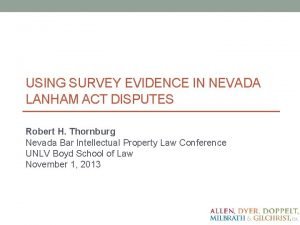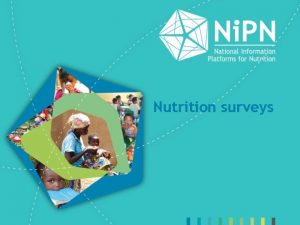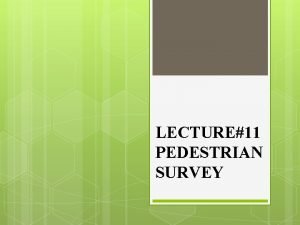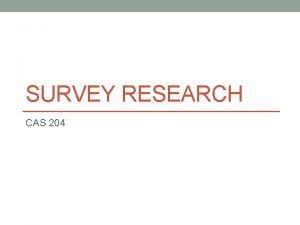Survey Methods Types of surveys l l l














- Slides: 14

Survey Methods

Types of surveys l l l Telephone Postal Internet Face to face Written questionnaires

General points l l l All methods have pros and cons Method selected will depend on things like time and cost Written questionnaires allow greater privacy Face to face / person to person allows dialogue / clarification Quality of questions is paramount – must be precise and unambiguous: “rubbish in equals rubbish out!” The larger the sample size the better

Pilot Studies – advantages l l l A brief trial study Checks that questions are understood / elicit the information you are looking for Avoids time / money being wasted on a survey which does not ‘work’ Improves the design / sharpens the questions Results could be ‘added’ to final survey

Pilot Studies - disadvantages l l Sample size likely to be smaller than final survey so results could be misleading Time taken – the intention of the survey could be out of date by the time the sample is completed

Face to face - advantages l l Higher response rate Responses can be elaborated on Skilled interviewer can get good information by further questions Questions can be further clarified if not fully understood

Face to face - disadvantages l l l Embarrassment factor – respondents may ‘lie’ / modify answers Quality depends on the skill and commitment of the interviewer Time consuming if large enough sample size to be achieved

Postal questionnaires - advantages l l l Quite cheap / straightforward Access to wide range of people / geographical areas Respondents less likely to be ‘embarrassed’ Answers likely to be longer that ‘in the street’ surveys Results can be coded, analysed, presented in different formats

Postal questionnaires - disadvantages l l l l Time consuming waiting to receive replies Low response rate, reduces sample size No opportunity to further explain questions May not sample certain groups – e. g. homeless. Response rate will vary by social class Unless questions are asked about ethnic group / age / social class of the respondents, the sample might not be representative Some respondents will not take it seriously – don’t consider answers etc.

Postal Surveys - examples l l Lancashire County Council Hillingdon Annual Public Health Report

Internet Surveys - advantages l l l Fairly cheap option Anonymous – reduces embarrassment factor People have time to consider their answers Can access a very wide sample Answers can be entered in a form which allows them to be codified, analysed Programmes available allow internet surveys to be quickly made up

Internet Surveys - disadvantages l l Sample restricted to those with computers / internet access People may not take it seriously Age profile likely to be younger Multiple responses can affect results

Examples l Hampshire Constabulary

Telephone Surveys – advantages
 Types of land surveys
Types of land surveys Secondary abcd
Secondary abcd Od survey methods
Od survey methods Inlay wax pattern fabrication
Inlay wax pattern fabrication Lanham act survey
Lanham act survey Snap survey software
Snap survey software Real eyes surveys
Real eyes surveys Observational study examples statistics
Observational study examples statistics Survey rebuttals
Survey rebuttals Physical security surveys
Physical security surveys Literature survey in research
Literature survey in research Surveys.panoramaed/everett
Surveys.panoramaed/everett Highway surveys
Highway surveys Partial discharge survey
Partial discharge survey Surveys experiments and observational studies 8-3 answers
Surveys experiments and observational studies 8-3 answers



























